

Tay's K9 Management
A place where Humans learn to think like a dog!
In-Home Dog Training Sessions
One Time Training Lesson - $100 1 hour Lesson
Bundle & Save 4 Week Course - $320 upfront ($80/ Lesson)
30 min Consultation or Follow up - $45 (Video Call Only)
Puppy Parenthood Package - $175 - (2 Hour Lesson)
Fair Use Act Disclaimer:
All pictures seen on this page are being used under Fair Use for criticism and educational purposes. If one of these pictures belongs to you and you want it removed, please message me in the "Contact Us" tab. In your message, use details to explain which picture(s) belong to you and I will remove them promptly. Thank you and enjoy!
The Importance of Body Language
Body Language and Communication:
-
Dog Body Language -
Ears: Forward (alert) – when a dog’s ears are forward, they are paying close attention to something/someone. While in this state, it might be difficult to gain the dogs attention back onto the person handling them. The dog may be so focused on what they are looking at that they may redirect on their handler if provoked or startled. Looking at an item or animal is not a sign of aggression or fear, the dog is likely trying to decipher if what/who they are looking at is friend or foe. If this dog were to be walking with their person, it would be important that the owner can still manage to get the dogs attention, to prevent any confrontation.
Ears: Sideways/resting (relaxed/ half-mast) – when a dog has their ears resting on the side of their head this is known as “half-mast”. The dog is pretty relaxed, they are not generally focusing on something in particular, nor are they showing signs of stress, tension, or fear.
Ears: Laid back on head (nervous, uncomfortable, non-confrontational) – when a dog’s ears are laying on the back of the head, or are held there with slight tension it means the dog may be unsure of a certain situation. They could be slightly anxious, uneasy, or weary of a nearby person or animal. Ears in this position show a dog that is not necessarily confrontational, or too terribly alert or showing their confident side.
Ears: held tightly on back of head (angry, defensive, protecting themselves) – When the ears are held tightly back with noticeable tension, it means the dog is likely feeling threatened or are defending something in their position. If a dog is showing “pinned” ears to another dog (or person), they are communicating to “stay away, don’t think about looking at my bone!”
Ears: Floppy vs. Pointy Ears – there are some differences in being able to understand the communication coming from a dog with floppy ears vs. a dog with naturally pointed ears. If you only rely on looking at the ears, you may have a tough time recognizing what the dog is trying to tell you or another dog nearby. The same goes for dogs who have had their ears cut off (example: Pitbulls)
Eyes: Squinty (relaxed, non-confrontational/ calming)- When dogs have squinty eyes, they are telling you that they are not wanting to start any conflict, they are trying to be respectful, so by showing squinty eyes they are being polite.
Eyes: Wide eyes/ whites visible (whale eyes, anxious, nervous, frightened)- If the whites of a dog's eyes are noticeable, it is not likely because they are just happy to see you, but rather a sign that they are anxious, stressed, or socially uncomfortable. When working with a dog whose eyes are dilated or the whites are showing, it is best to give the dog space and a break from whatever activities or training they are taking part in. Most importantly, DO NOT STARE AT THE DOG, ESPECIALLY EYE CONTACT!!
Eyes: Making direct eye-contact (nervous, defensive, offensive)- Dogs do not make direct eye contact with one another unless they mean business. Most of the time a dog will avoid eye contact with other creatures, including people. Although it is respectful for humans to make eye contact with each other, it is a very aggressive move to make when dealing with animals of any species.
Eyes: Looking away (nervous/respectful/non-confrontational) – If you should notice a dog looking at you, but looking away with quick, short movements, the dog is giving you a calming signal/clue to not stare as much, calm your energy, or you are making the dog too nervous at the moment.
Eyes: Holding eye-contact for more than 3 seconds (staring, looking at something = thinking about something, going to act out toward staring victim) – If a dog is doing the staring at anything in particular, that means they are likely thinking about that item/person/animal. If they are thinking about it, they may react to the stimulus defensively (protecting themselves), they may react offensively (aggressive), or they may be curious and want to investigate. Whatever the reason for the dog to become fixated on something, should the "something" be you, and the dog is reacting to your presence by staring at you and not breaking eye contact after a few short seconds, then it is the humans responsibility to break the stare with a look away or by moving away. DO NOT ATTEMPT TO PLAY THE ROLE OF ALPHA BY STARING THE DOG DOWN UNTIL THEY BREAK FIRST, IN AN EFFORT TO SHOW THE DOG WHO IS BOSS!! THIS WILL ONLY MAKE MATTERS WORSE, DONT FLOOD THE DOG WITH A STARE DOWN TO THE DEATH, THE DOG WILL ALWAYS WIN!!!


-
Panting when the dog is not hot or recently exercised, yawning when not recently sleeping, salivating (dripping or drooling) *hyper-salivation, whites of eyes are visible (whale eyes) tension lines throughout the face, whining uncontrollably, muscle tremors, pacing, scratching body (possibly to the point of hair loss or broken skin), constant licking of objects or own body, stiff tail, closed mouth, ears back, avoiding eye contact, spatula tongue (with or without being curved upward towards nose), paw lift, short lips, eyes darting back and forth, high pitched barking, avoidance behavior.
It is important to be able to easily recognize these types of behaviors to prevent your dog form becoming too stressed. If you do nothing to lesson the pressure being put on your dog, the dog will be emotionally flooded.
*flooding definition*
Just about anything in a dog's environment can cause a dog to become stressed. Thunder, loud music (live or on the radio/TV), car rides, trips to the vet, trips to a new environment, moving, new furniture, new pets, new people, dishes being dropped or broken, etc. There are countless stressful moments that will happen in your dog's lifetime, and there's no way to prevent them from happening. Instead it's our job to prepare our pets for these stressful encounters. It's natural for dogs to be fearful of strange things, but it's important for them to learn not to be afraid of what scares them. Every time you find something that scares your cog, make a point of teaching them how to overcome their fears. For example, if a dog is afraid of the sound of metal bowls hitting the ground, start there. Take the bowl and show it to the dog, every time the dog doesn't react negatively, praise and reward. Repeat these steps a few times to reinforce the dog giving the right answers (that being the dog is not backing away form the bowl). Then add a bit more pressure by tapping the bowl very lightly on the ground to make a slight sound, praise and reward. Continue these steps little by little, adding more pressure and noise each time until your dog sees that this bowl is nothing to fear.
Flooding can be caused by over stimulating the dog with something negative, this can be something as simple as bushing the dog, but forcibly holding them down and making them put up with it. By forcing any dog to put up with a stimuli they find to b unpleasant, you are creating a negative association of that stimuli. i.e. brushing is not something nice, so they will avoid it at all costs to prevent being in an uncomfortable environment. If a dog begins to show avoidance behavior towards something they find undesirable, they are not being mean, aggressive, stupid, dumb, or trying to make their human look stupid in front of others. The dog is doing what works for them, they are smart enough to know that if they find a way to run away from something they don't like for long enough, they don't have to deal with it. When humans put their emotions onto their animal's actions and make excuses for why they don't understand their dog's actions, the human creates more problems. (mostly for the dog!) A dog is being a dog, a horse is being a horse, and a cat is being a cat, nothing more, nothing less.
Examples and Explanations of Body Language

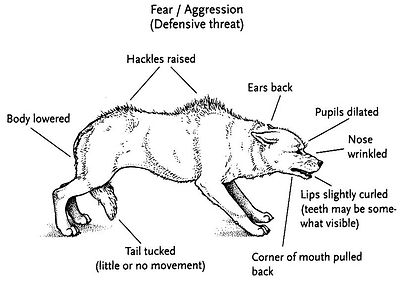
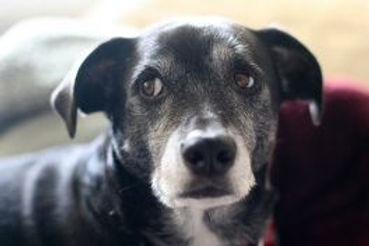
This dog is giving a very clear "look away" or "eye flick". Without any other context, we can't be sure why this dog is giving this calming signal. It could be because another dog or person is near or look at the dog, or it could be directed at the camera's eye because it stares without blinking. *Note the closed mouth, and position of the ears. This dog is slightly uncomfortable, but still not threatening anyone.*

I don't know about anyone else, but everything in this photo screams dangerous to me! The dog is chained with limited means of escaping the pressure the child is putting on them. As if that's not bad enough, the child is keeping the dog where they are and holding onto the muzzle with their fingers wrapped around the entire mouth. The dog might be making direct eye contact, but that's not entirely clear from this angle. However, what is painfully clear is the dog's body language and the body orientation in which the dog is leaning away from the tiny predator. Whether you or the toddler know it, both characters in this picture are predators, and when two predators come face to face, something is going to happen. It's not a matter of if, but rather when, and this innocent child is no match for the sheer strength and speed of even a medium to small sized dog such as this one. Everything in this situation is teaching the dog an important lesson, that doesn't mean it's going to be something good.

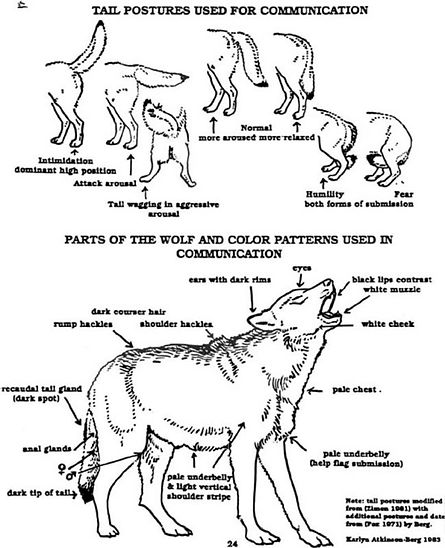
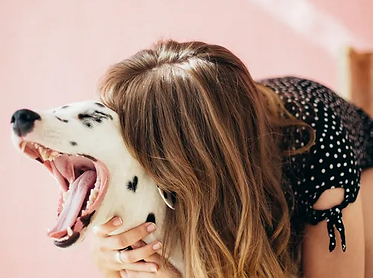
This dog is yawning and squinting their eyes. This behavior is VERY likely being caused by the person smothering their face into the dog's ear. Even though the person is trying to show affection, chances are, the dog is not very comfortable with the invasion of their space. When you see a dog doing this type of behavior and they have not recently woken up from a nap, take care to focus on the rest of the dog's body language to avoid stressing the dog even more.

In this picture, these two dogs are talking to each other. It may not be as obvious to some as it may be to others, but each behavior you see being displayed is actually intentional. Start with the light brown dog on the left, their tail is up, front end hunched over engaging in a sniff, all four feet are planted on the ground, eyes looking toward the direction of the other dog while still avoiding eye contact, and the head (business end) is leaning in toward the other dog. Now take a look at the black dog on the right. This dog is leaning away from the on-looker with the left front paw slightly raised, upper body lowered in a sniffing position, eyes are facing the ground (not entirely clear of exactly where the dog is looking), tail raised and ears are slightly back. Both dogs are talking to each other through this intentional body language. What are they saying? Well look at what they have in common and what they don't. Both tails are raised, neither dog is facing directly toward the other, and they are both sniffing. Coincidence? I think not! Remember that seemingly random sniffing can also be a calming signal, along with the sideways stance and the body orientation leaning towards or away from one another. These two dogs are confident, but also polite as neither one is showing signs of trying to start a fight with the other.
The dogs in this image are showing stress in different ways. The two on the outside (the husky on the left and the ausie on the right are leaning away from the two dogs in the center. The vizla has a tightly closed mouth and the mixed breed is yawning. The two outside dogs have open mouths, but the Australian shepherd almost has a smile going on, showing long lips (calming signal). These are signs the dogs are stressed out by being in such close quarters to each other, along with whatever is going on in the environment. Dogs like their personal space, and when they are forced to sit next to another strange dog, they are very likely going to show stress signals like these to prevent a fight from breaking out. Smart dogs for putting up with this, stupid human for putting them in this position.
Alpha Rolling and Dogs
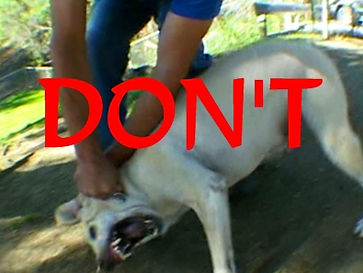

What is Alpha Rolling?
Alpha rolling is the act of forcibly pinning a dog onto their side and keeping them in that position for a number of minutes, or until the dog show's "submission".
Alpha role by definition - The alpha roll is a controversial dog training technique. The theory behind the training method is to teach the dog that the trainer is the pack leader (or alpha animal). Misbehaving dogs are pinned on their back and held in that position, sometimes by the throat.
Submission by definition - the action or fact of accepting or yielding to a superior force or to the will or authority of another person.
If a human is to alpha role any other animal, especially one who is unmistakably a predator (dogs of any breed) it is only a matter of time before the dog reaches a breaking point and reacts in an explosive manner. The victim and receiver of the dogs reaction may not always the person who enforces the alpha rolling of the dog.
Alpha rolling is a common practice amongst many cultures and highly praised and promoted within the dog training community. But is it really necessary? Just because dog's do it to seemingly gain the upper hand over the other, does that mean that humans have the right to try it? Dogs do many strange things that I would never consider partaking it, such as sniffing each other's... well, rear ends, eat food off the floor, chase anything that moves, clean their privates with their tongues (with their tongues!), sleep throughout much of the day, enjoy chewing on bones and bully sticks/ pizzle sticks (aka dehydrated bull penis), not to mention one of the nastiest habits of eating their own excrement, their neighbor's, or that of cats, bunnies, and the occasional cow or horse from the farm next door. Why do dogs do the things they do? Well, from a simple point of view, one might just answer, "because they're dogs, that's just what they do!" But if you look into the behavior a little further, you might find more detailed reasoning as to why dogs do what they do. For instance, a dog might eat their own waist because they are missing essential nutrients in their diet. To a dog whose sense of smell is far greater than that of a human's, the dog doesn't just smell the layer of bacteria breaking down the waste product, but they can still detect what they just ate, if this poop is that of a prey animal or predator, as well as the anal glands secretion that is spread amongst the waist while it exits through the body. A dog will also eat their waist if they are anxious, hungry, or just bored and have nothing better to do than pass the time.
A good reason for why dog's sniff each other's anus is more direct than first thought. As mentioned previously, dog's have 2 anal glands that sit inside the rectum. As the solid waist moves through, it squeezes against these glands causing them to express themselves. When another dog comes to sniff the present left behind, they are picking up a lot of information about who was just in the area. A simple sniff can tell an individual if the dog is male or female, neutered or spayed or still intact, pregnant, in heat, in musk, sick, older or younger, as well as if they are strong and healthy. So much can be learned with a few whiffs of something most humans see as degrading and disgusting. Silly human's have no idea if there is a larger predator stalking them or warning them to stay off their turf by marking their grounds!

Alpha rolling your own beloved pet to rid them of unwanted behavior probably isn't the first thing on your list, or even the second or third for that matter. But as time goes on and patience grows thin, even the best intentions begin to fade and give way for the sake of your own sanity! Especially while muzzled!

It's hard not to listen to those closest to you when you're looking for helpful advice, especially when they sound so sure of what they're talking about. "Just pin him down to show him who's alpha, he needs a real pack leader, lose the treat crap!"
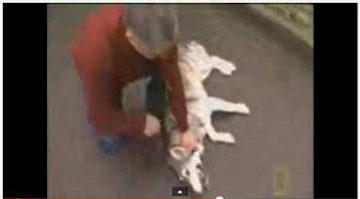
It's understanding to see why pet owners of any experience would chose to blindly listen to whomever will give them an answer to their problems. The most popular ideas come from those with celebrity status such as "The Dog Whisperer" himself!
Cesar Millan Alpha Rolling A Wolfdog Hybrid On His Hit TV Show
*more on my rant about hybrids in another section*
